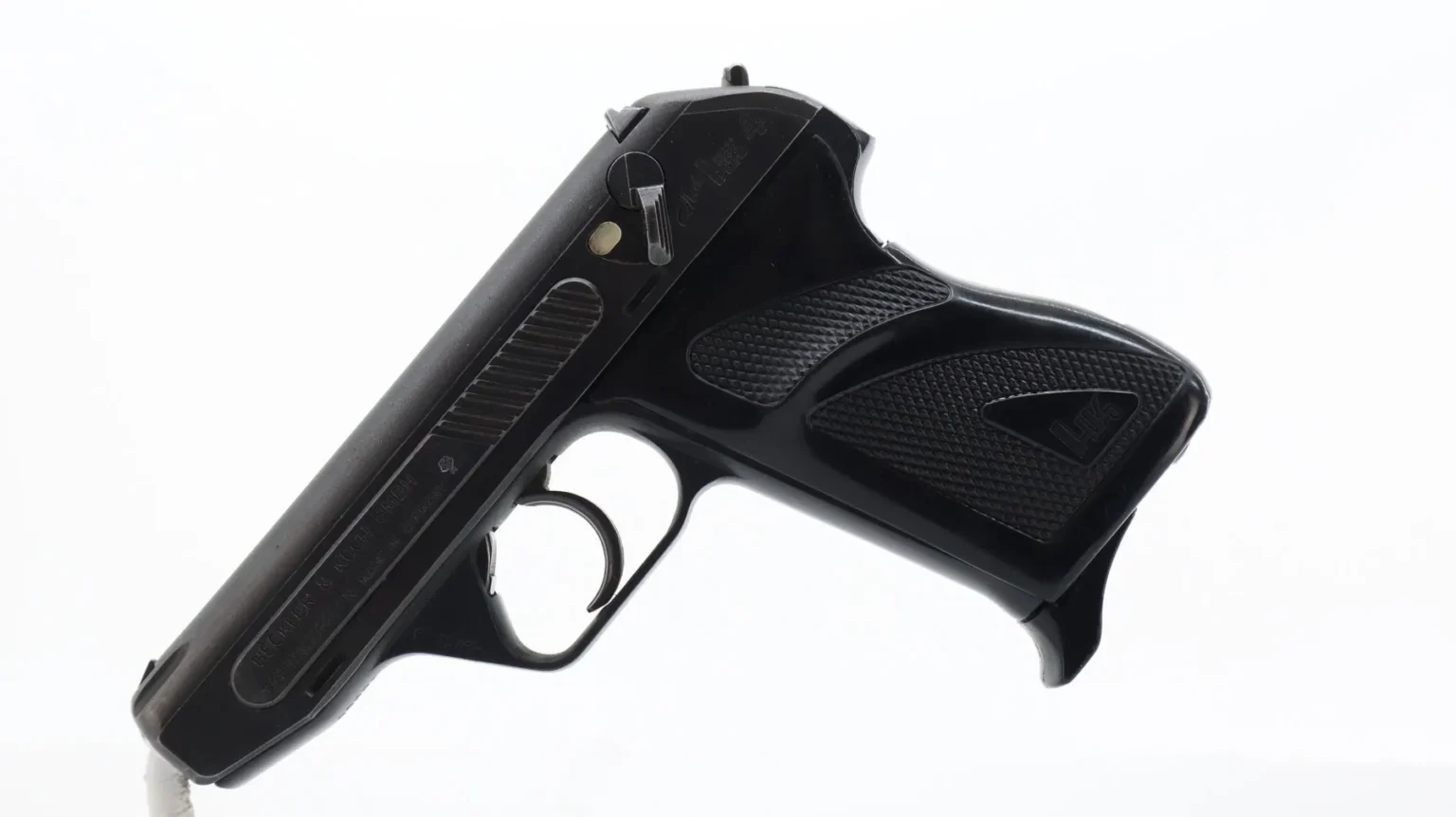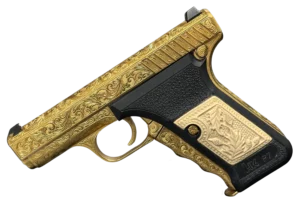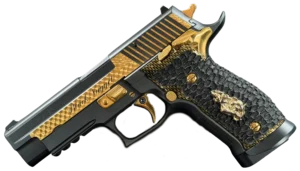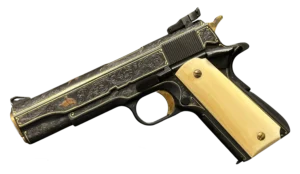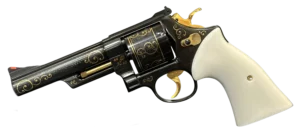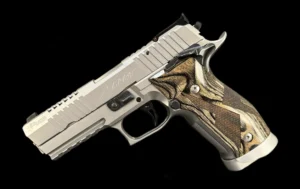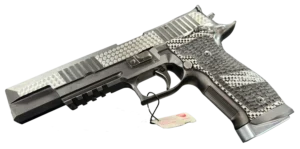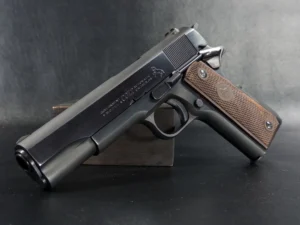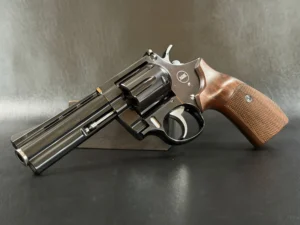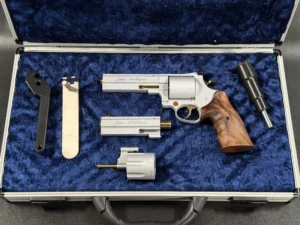Key Takeaways:
- Unmatched Modularity in a Compact Handgun: The HK4 was the first pistol to offer seamless caliber conversion between four cartridges. 22 LR, .25 ACP, .32 ACP, and .380 ACP—without tools. Its modular design made it a versatile solution for civilians, law enforcement, and customs officers, able to function as a training pistol, defensive weapon, or backup firearm.
- Innovative Engineering with Practical Safety Features: The pistol’s aluminum frame, interchangeable slide assemblies, and unique chamber groove designs tailored to each caliber showcased advanced engineering. HK4 also prioritized user safety, featuring multiple built-in safety mechanisms, including a trigger block, slide-mounted safety lever, and disassembly safety.
- Historical Significance and Collector Appeal: Although it never rivaled the Walther PPK in market dominance, the HK4 left a lasting legacy of modularity that has influenced modern handgun designs. With special variants, limited editions, and international markings, the HK4 has become a prized collectible and a key milestone in Heckler & Koch’s design evolution.
The Heckler & Koch HK4 stands as a unique achievement in firearms history—a pistol that brought true modularity to the civilian and law enforcement markets. Introduced in the late 1960s, the HK4 was not only Heckler & Koch’s first production handgun but also one of the most adaptable pistols of its time. Engineered to accommodate four different calibers.22 LR, 6.35mm (.25 ACP), 7.65mm (.32 ACP), and 9mm Kurz (.380 ACP)—the HK4 offered users unmatched versatility in a compact and elegantly designed package.
Origins and Engineering Vision
The HK4 project began as a natural evolution of Heckler & Koch’s ambition to enter the pistol market. Founded in the aftermath of World War II by former Mauser engineers Edmund Heckler, Alex Seidel, and Theodor Koch, the company quickly gained recognition for its craftsmanship and innovation. By the mid-1960s, having already found success with military rifles like the G3, H&K turned its attention to service pistols.
Alex Seidel, one of the HK4’s principal designers, had been a key figure in developing the Mauser HSc. Drawing on this experience, the HK4 incorporated many HSc design cues—most notably its streamlined silhouette, double-action trigger, and blowback operation. But the HK4 advanced beyond the HSc by offering a level of adaptability previously unseen in commercial handguns.
The Modular Design: Four Pistols in One
The HK4’s standout feature was its ability to convert between four calibers without the need for tools. A user could switch from .22 LR to 9mm Kurz in a matter of minutes by simply swapping out the barrel, recoil spring, and magazine. To accommodate the rimfire and centerfire differences, a breech block plate inside the slide could be rotated to adjust the firing pin alignment.
Each caliber kit came with its own uniquely tensioned recoil spring, precisely tuned for the specific pressure characteristics of the corresponding cartridge. Barrels were stamped with caliber markings, and the current caliber in use could be viewed through the ejection port, adding a layer of user safety and operational awareness.
This interchangeable system made the HK4 highly attractive to law enforcement agencies, customs officers, and civilian shooters. A single pistol could serve as a low-recoil training tool with .22 LR, a discreet backup gun in .25 ACP, or a compact defensive weapon in .380 ACP.
Chamber Grooves: A Solution to Caliber-Specific Challenges
Each caliber posed unique technical challenges. Heckler & Koch responded with clever engineering solutions, particularly in chamber design.
- .22 LR Version: This rimfire round lacked the pressure required to cycle the slide reliably, so pressure-relief grooves were cut into the chamber to reduce friction and facilitate extraction. These grooves allowed gas to “float” the cartridge, reducing adhesion to the chamber walls.
- 9mm Kurz (.380 ACP): As a higher-pressure round, this required more resistance during the cycling process to avoid slide battering. Engineers added a stress groove to the chamber, allowing for slight case expansion and creating a delay effect similar to modern delayed blowback systems.
- 6.35mm and 7.65mm: These centerfire calibers operated at moderate pressures, so traditional smooth-walled chambers sufficed.
While innovative, later production barrels omitted these grooves, suggesting that improved metallurgy or manufacturing techniques had resolved some of the extraction issues they were designed to mitigate.
Prototypes and Evolution
The HK4’s development included a series of prototypes, each reflecting incremental improvements. Early test models like the VM 0028 featured two different extractor slide configurations, ramp-shaped trigger guards, and wider cocking serrations.
Later iterations, such as the VM 0043 and VM 0044, showcased satin finishes and updated ejection port geometries. The production-ready design debuted with serial number 10,001 and included a rounded trigger guard and 18 narrow cocking grooves, echoing the aesthetics of the Mauser HSc.
These progressive refinements demonstrated H&K’s commitment to rigorous testing and user feedback, ensuring a polished product by the time of its commercial release.
Aesthetics and Construction
The HK4 was built around a pressure-cast, anodized aluminum frame—lightweight, corrosion-resistant, and exceptionally durable. It housed the hammer-fired ignition system, slide rails, and a well-contoured trigger.
The slide was formed from stamped sheet steel with welded inserts and guide ribs, finished to high tolerances. Internally, it included an easily removed breech block, firing pin, ejector, and a dovetailed plastic rear sight.
Two primary variants emerged throughout its production:
- First Variant: 18 slide serrations at the rear, brown plastic grips, and an engraved three-line inscription on the front left of the slide.
- Second Variant: Moved the serrations forward, added a metal side plate for branding, and generally featured black grips.
All variants had the serial number stamped on the underside of the frame in front of the trigger guard.
Technical Safeties and Controls
The HK4 prioritized user safety with multiple built-in safeguards:
- Slide-mounted Safety Lever: Disconnects and lowers the firing pin, preventing accidental discharge.
- Trigger Block: Disables trigger pull unless the magazine is inserted.
- Slide Lock: Prevents the hammer from releasing unless the slide is fully closed.
- Hammer Catch: Retains the hammer if the cocking process is interrupted.
- Disassembly Safety: Requires secured conditions for safe takedown and reassembly.
These features made the pistol safe for daily carry and provided peace of mind for users in both civilian and professional roles.
Commercial Production and Global Sales
Mass production began in 1968. By 1984, over 38,000 HK4 pistols had been manufactured:
- 25,800 sold on the civilian market
- 12,400 issued to German customs police (Zoll)
- 8,700 imported to the United States via Harrington & Richardson (H&R)
The HK4 was competitively priced—significantly cheaper than its main rival, the Walther PPK—while offering greater caliber flexibility. Although it never displaced the PPK in law enforcement circles, it gained a loyal following and carved out its niche, particularly among collectors and firearms enthusiasts.
Special Variants and Collectibility
Several notable HK4 variants were produced during its run:
- H&R Commemorative Models: In 1971, H&R commissioned a 100th Anniversary edition, featuring gold triggers, presentation cases, and serial numbers ranging from HR00001 to HR08700.
- MAS-Marked Pistols: Due to Cold War export restrictions, some pistols were rerouted through France’s MAS factory, bearing French proof marks. These were sold to West Berlin police and have become highly collectible.
- BWB (Bundeswehr) Models: Issued to West German military or federal entities, often marked “BUND” on the frame.
- Light Dot Training Pistols: A non-lethal variant using a built-in light beam for marksmanship training, emphasizing H&K’s commitment to law enforcement needs.
These rarities, along with engraved presentation pieces and four-caliber sets, are now highly sought after among collectors.
U.S. Import and Markings
In the U.S., the HK4 went through various importers and slide markings over the years:
- H&R Worcester, MA
- SACO ARL VA
- HK INC CHANTILLY, VA
- HK INC VA 22201
These inscriptions help date specific pistols and identify their import path, offering additional appeal to historians and collectors.
Reception and Legacy
Though it never unseated dominant pistols like the Walther PPK, the HK4 succeeded as a proof of concept. It showed that a modular handgun platform could be reliable, user-friendly, and practical. Its true successor, the HK P9S, built upon many of the HK4’s lessons, taking HK deeper into the world of cutting-edge pistol innovation.
The HK4’s influence also foreshadowed future modular handguns, such as the SIG Sauer P320 or Glock’s multi-caliber variants, which are prized today for their ease of customization and adaptability.
More than 50 years after its introduction, the HK4 remains a compelling blend of utility and design—an example of engineering that pushed the limits of what a service pistol could be.
Conclusion
The HK4 isn’t just an early H&K handgun—it’s a milestone in modular firearm development. Offering four calibers in a single platform, wrapped in precision German engineering, the HK4 delivered innovation at an accessible price. Although no longer in production, its legacy endures, not only in collections and training manuals but also in the DNA of every multi-caliber firearm that followed.
Although it may not have dominated the market like its successors, in terms of technical influence, the HK4 left a lasting mark.
Frequently Asked Questions
The HK4 is capable of firing four calibers: .22 LR, 6.35mm (.25 ACP), 7.65mm (.32 ACP), and 9mm Kurz (.380 ACP). Users could switch between them by changing the barrel, recoil spring, and magazine.
Very easy—no special tools are required. Conversion takes only a few minutes, and the barrel, recoil spring, and magazine are swapped. A rotating breech block plate helps align the firing pin for rimfire or centerfire rounds.
The HK4 was intended for both civilian and law enforcement use. Its adaptability appealed to German customs officers, international police agencies, and private firearm owners alike.
Its modular caliber-conversion system was revolutionary. Most era pistols were limited to one caliber, whereas the HK4 offered four in one firearm—something rare and advanced for the late 1960s.
Yes. There were at least two primary production variants, commemorative editions, and special issue models, including BWB (Bundeswehr) variants, MAS-marked exports, and a non-lethal light beam training version.


